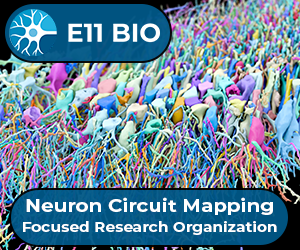On science blogs: the brain — yours, mine, and theirs
BAM BAM BAM: WHAT IS THE BRAIN ACTIVITY MAP? Last week I noted that there hasn't been much blogging yet about the Brain Activity Map, the (potentially) giant new US neuroscience research effort that is supposed to be vast and expensive but so far is otherwise ill-defined. This week there's more, and it all seems to ask the same question: What the devil is BAM? Is it even a Project at all? Or is it just a vague collective label for unspecified neuroscience research — all of which is, after all, mapping brain activity?

BAM is being often compared to the Human Genome Project, but the comparisons seem to me misleading at best. Or perhaps I mean irrelevant. There are as yet no well-defined goals like the HGP's mapping and sequencing of human DNA. Or, at this point, any particular goals at all.
BAM doesn't seem to be centralized in a single agency, like the Genome Project was at NHGRI, the National Human Genome Research Institute at the National Institutes of Health. Instead it is to be run out of the White House's Office of Science and Technology Policy, or maybe NIH, and include other government funding agencies such as the National Science Foundation but also, somewhat ominously, the Department of Defense's Defense Advanced Research Projects Agency. (Robosoldiers? Intelligent drones? Brain implants that control and channel aggressive behavior?) Private research organizations — the Kavli Foundation, Howard Hughes Medical Institute, the Allen Institute for Brain Science — also seem to be involved, and so are computing heavyweights like Microsoft and Qualcomm.
Knight Science Journalism Tracker Faye Flam looked at some of the journalism describing BAM and pronounced it light on details about what the project is, what it will be doing, and who will be doing it. She's certainly correct, but I'm not sure that's the fault of journalists. The stories are light on details because it's now pretty obvious that the project is light on details. Embryonic, if that. It's not yet settled what the project is, what it will be doing, and who will be doing it — although of course it would certainly behoove journalists to point out that the emperor needs to do something about his nudity.
BAM BAM BAM: THE BLOGGERS SPECULATE. Mind Hack's Vaughan Bell tries to figure out what BAM might be by comparing it with the European Commission's Human Brain Project, priced at half a billion euros (assuming the euro survives.) Bell says the announced purpose of this project — to simulate a complete human brain in a supercomputer — is "bollocks."
What the project aims to do is co-ordinate neuroscience teams looking at neurobiology, cognitive neuroscience and computational modelling and give them the tools to easily share data with each other.

In short, a Big Data project that simply can't be sold politically. Hence the supercomputer brain simulation hand-waving, which is sexier-sounding but twaddle. Bell does concede that one of the payoffs will be computer simulations of neural networks. So for me one obvious question about BAM is: How will it fit in with the European Commission's Human Brain Project? Surely it makes sense to engage in some coordination to avoid duplication and unnecessary overlap?
As for the US's BAM, Bell says it's vague so far because it's a political response to what Europe is doing, still waiting to be fleshed out. But he is happy indeed that this competition is revving up. It will, he forecasts, mean "a decade of massive innovation in neuroscience."
NeuroDojo Zen Faulks is more cynical and a lot less hopeful. His post on BAM is one of several of his laments that science is being marketed as disease cures — a ploy that in the long run, when the cures fail to materialize in a trice, erodes public trust in science. He notes that BAM is being sold as “Neuroscience! Because Alzheimer’s!” And yet basic neuroscientists
are talking about what is technically feasible, whether this is better done as one big project of funding lots of small ones. But neuroscientists are not talking about curing neural diseases as a reason to do this project. Mainly, they are seeing this as a chance to get a lot of fancy new toys to record activity from a lot of neurons at once.
And just in this morning: Virginia Hughes has an interview with the Kavli Foundation's Miyoung Chun at Nature's Spoonful of Medicine. Only some detail, but it does seem clear that BAM's emphasis will be, as Faulks foretold, on fancy new toys, uh, technology. And, in marketing news, Chun also mentions the potential for neural prostheses.
BAM BAM BAM: C. ELEGANS & ZEBRAFISH? I did find one blog post with a lot of detail, the take by Emily Underwood and Jocelyn Kaiser at ScienceInsider. Whether the final ideas will look anything like their description is unknowable, but here are some things they say.
They agree with Faulks that BAM will be developing tools to monitor large groups of neurons simultaneously. One crucial factor, Underwood and Kaiser say, is that at this stage the planning documents don't seem to involve the human brain at all or much in the way of potential human applications. In the first 10 years at least the emphasis — and the money — will be on animal models.
After 5 years, scientists suggest that they will be able to monitor the equivalent of the whole brain activity of the roundworm Caenorhabditis elegans, which has 302 nerve cells and roughly 7000 connections. After 10 years, they expect to complete the whole brain map of the fruit fly model Drosophila, about 130,000 nerve cells. After 15 years, they predict that they will be able to observe the function of the zebrafish brain, or several areas from the mouse cerebral cortex.
Scientifically speaking, that schedule may be sound and even challenging and ambitious. But is it saleable? At a time when money is a big issue and politicians are expecting to hear "Neuroscience. Because Alzheimer's"?
I can imagine the response. Five years on a worm? Fifteen years to get to zebrafish? Are you nuts? Zebrafish? What in hell are zebrafish? Are you guys trying to do animal genetic engineering again?
SHIRT TALES: SCIENCE E-BOOKS. Carl Zimmer, who started it, celebrates the first birthday of Download the Universe, the site where science writers review science e-books. There have been some beauties, and he describes a few. But he also notes that a distressing proportion of science e-books are unworthy. Some are simply plucked entire from other media — collections of newspaper articles or digitized TV shows. Some are just crap outright. It all makes glaringly obvious one thing that all but a few e-books lack, and that's editors. My take is that, since one of the points of e-books is low (or no) overhead, lack of editors is not a problem likely to be fixed.
SHIRT TALES: OBAMACARE ADDENDUM. Writing last week about the new mental health coverage to be provided under Obamacare, I speculated that limits would be placed on talk therapies because they are so much more expensive than meds. John Gever writes to point out that the Mental Health Parity Act forbids insurers from imposing limits on mental health benefits that they don't impose on other kinds of medical services such as surgery. The act was passed in 2008, and it doesn't seem to be clear yet how it will mesh with Obamacare. The act apparently does not, for example, apply to substance abuse treatment; will that also be true of Obamacare?
SHIRT TALES: THE MEDITERRANEAN DIET. I have shrunk away from writing about the flap over the new Mediterranean diet research, at least until more dust settles. In the meantime, consult the New England Journal of Medicine's CardioExchange for a roundtable from 3 expert heart docs. They are all fans and were particularly impressed with the PREDIMED study's statistical power.
SHIRT TALES: INCREDIBLE BIOLOGY RICHES. I can hardly believe such a thing is possible, but you can take an Intro to Biology class that is 1) taught by genomics etc star Eric Lander and colleagues; 2) at MIT; 3) online; 4) FREE. Begins next Tuesday (March 5), runs through the end of May. If you do the work, you get a certificate, but it also sounds as if you can just listen to the lectures. Even the textbook — the classic Molecular Biology of the Cell — is available free (and searchable!) online. Extraordinary. Info and registration here. HT to Ed Yong for the link.




